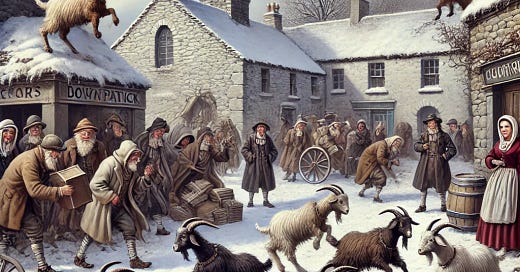Welcome back to This Day in Irish History. I'm your host, Raymond Welsh. Today, we turn our attention to one of the quirkiest and most puzzling entries in Ireland's rich tapestry of folklore and history. On January 15, 1702, County Down witnessed an event so peculiar that it has become known as the “Lamentable Goat Affair.”
The incident, shrouded in the mists of half-remembered anecdotes and embellished retellings, is said to have occurred near Downpatrick. The earliest account we have comes from a brief mention in a local broadsheet, describing how several goats escaped from a market pen. What followed was a chaotic series of events that reportedly brought the entire town to a standstill.
According to the fragmentary reports passed down through local histories, the goats were being sold at a market that January morning. As the tale goes, a mishap—possibly a broken pen or an inattentive herder—allowed the goats to bolt free. What could have been a small inconvenience quickly spiraled into bedlam as the spirited animals darted through streets, gardens, and homes, evading capture at every turn. The account notes that the goats’ antics inspired a mix of amusement, frustration, and outright pandemonium.
The townsfolk rallied to reclaim the runaway animals, forming what might best be described as a comical chase. Imagine a cold winter morning with people in heavy cloaks and boots slipping on the frosty cobblestones, yelling instructions to one another while the goats gleefully bounded out of reach. These nimble creatures reportedly leaped over walls, knocked over goods, and even entered a few homes, causing minor havoc and leaving chaos in their wake.
Though the historical veracity of the “Lamentable Goat Affair” has been questioned, the cultural memory of the event persisted. Local legends expanded on the story, claiming that one particularly determined goat climbed onto the roof of a shop, bleating triumphantly while a crowd gathered below. Another tale suggests that one of the animals led pursuers into a nearby church, disrupting a service and allegedly earning itself a nickname: “Holy Hooves.”
What makes the story so enduring is how it reflects the character of local Irish communities at the time. Life in 1702 was challenging, with political tensions, economic hardships, and a climate that often tested resilience. An event like the goat escape offered a rare moment of levity. For one morning, the usual concerns of daily life were overshadowed by the shared experience of an absurd, if fleeting, spectacle.
The “Lamentable Goat Affair” also highlights the role of oral tradition and local newspapers in preserving quirky, ephemeral events that might otherwise have been lost to time. While today we might look to social media for stories of animal antics, in 1702, broadsides served as both news outlets and purveyors of local color. The brief snippet about the event may have been printed more for its entertainment value than its historical significance, but it endures as a small, endearing glimpse into everyday life in early 18th-century Ireland.
As we consider this tale, it’s worth noting how such stories grow and evolve over time. Whether all the details are accurate or embellished by imaginative storytellers, the “Lamentable Goat Affair” reminds us of the joy in shared community experiences—even when the stars of the show are, quite literally, stubborn goats.
Thank you for joining us on today’s whimsical journey into the past. Be sure to tune in tomorrow for another episode of This Day in Irish History. I'm Raymond Welsh, and until then, Slán go fóill.













Share this post